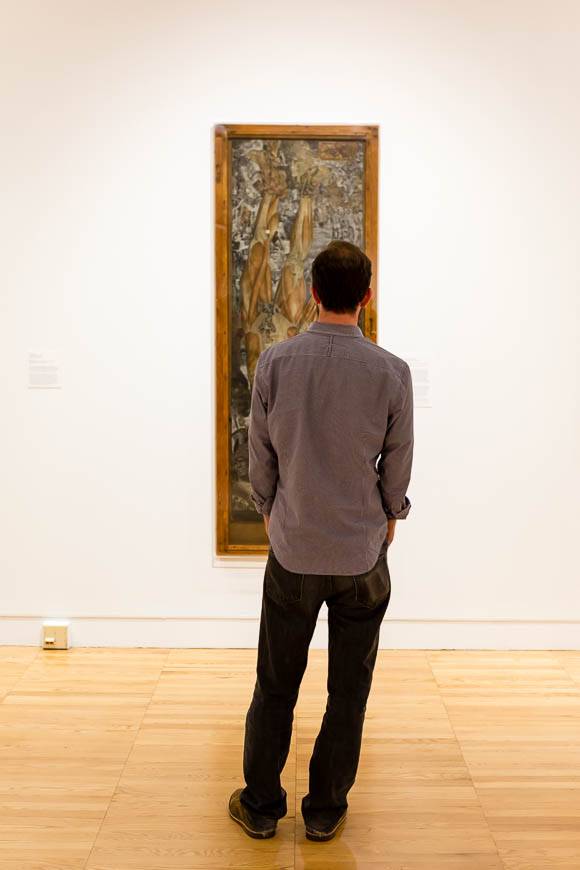One of the things that I love about C-U is the same thing that also intimidates me: we have an enormous arts culture that is both world-class and filled with extraordinarily knowledgeable people. I’ve known for years that our community’s art museum reflects the same dynamic, owning works by big recognizable names and curated by people who know what they’re doing. Still, I have to admit that the longest periods I’ve spent there have been for the rock concerts and shows put on, usually during Pygmalion music festival, and maybe I would wander around the gallery a little bit afterwards going “Oh! Look! A Wegman!”
The same was true for me on Opening Night — I had just come from work and was headed to a wedding shower, I had about 45 minutes to hit the highlights. Thanks to my press credentials, I had met Julia Kelly from marketing, who steered me towards the most notables, and in doing so, I had to pass quite a few pieces that made me want to come back. After running around like crazy on Thursday, I scheduled a date with a friend to return on Saturday and spend a couple hours, but it still wasn’t enough.
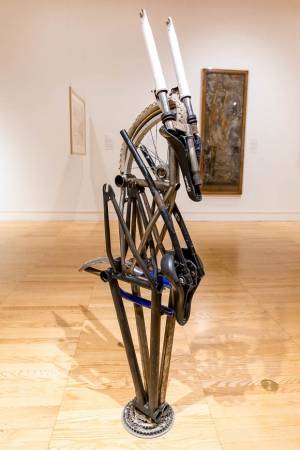 Julia pointed me toward a recent acquisition, Work Animal II, a sculpture by artist Willie Cole, an African-American artist who has used his work to make statements about both continents. The acquisition of this piece, which creates a chi wara out of bicycle parts, was made possible by a donor who wanted the Krannert Art Museum to continue its important and award-winning work preserving and displaying African art and artifacts.
Julia pointed me toward a recent acquisition, Work Animal II, a sculpture by artist Willie Cole, an African-American artist who has used his work to make statements about both continents. The acquisition of this piece, which creates a chi wara out of bicycle parts, was made possible by a donor who wanted the Krannert Art Museum to continue its important and award-winning work preserving and displaying African art and artifacts.
To get to the sculpture, I had to walk past an odd blue chair, a fiberglass girl, a couple of Warhols and an oily-black hanging teardrop. Behind it was a gorgeous shiny portrayal of the Hanged Man tarot card as anatomical drawing behind a screen door. An angled wall hid a corner full of glimpsed works that needed further contemplation. These components of the Attachment exhibition made me resolve to come back when I had more time.
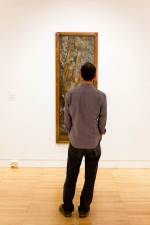 I understood the idea behind the theme — that certain things create connections — but when I ran through the rooms quickly on Thursday, I found myself puzzled by certain placements: why are there so many portraits in the “Accumulations” section? Why is the Warhol Marilyn in “Appendages”? When I was able to come back and spend time strolling, considering, and discussing these things with my friend, I was able to truly appreciate the added dimension of curation, and how items grouped together in a particular fashion take on more meaning than if they were just displayed because the museum owns them. My advice to anyone walking through on the way to the chi wara is to slow down and actually read the prompts written on the wall, and think about those ideas as you view the works as a group. It might be museum-going basics to an art-lover, but to the general population, I think it might be the kind of lost art that should probably be found again, and it really added to my experience.
I understood the idea behind the theme — that certain things create connections — but when I ran through the rooms quickly on Thursday, I found myself puzzled by certain placements: why are there so many portraits in the “Accumulations” section? Why is the Warhol Marilyn in “Appendages”? When I was able to come back and spend time strolling, considering, and discussing these things with my friend, I was able to truly appreciate the added dimension of curation, and how items grouped together in a particular fashion take on more meaning than if they were just displayed because the museum owns them. My advice to anyone walking through on the way to the chi wara is to slow down and actually read the prompts written on the wall, and think about those ideas as you view the works as a group. It might be museum-going basics to an art-lover, but to the general population, I think it might be the kind of lost art that should probably be found again, and it really added to my experience.
Also present on Thursday night was Guen Montgomery, a participant in the Art + Design Faculty Exhibition. She spent at least an hour on the floor in what appeared to be Civil War regalia of both genders, carving away negative space from her work, and she will continue to do so in two-hour stretches three days a week: Mondays, Wednesdays and Fridays, 2-4pm while the exhibition runs. The placard did not specify whether the costume would be present at all or any further performances.

Pictured behind Guen is a work by Chris Kineke, which hurt my eyes in a way that getting too close, like way too close, to a CRT TV used to, and resembled the effect as well. In fact, don’t take this the wrong way, but many of the works in the Faculty exhibition made me uncomfortable, which to me means they are doing the work of 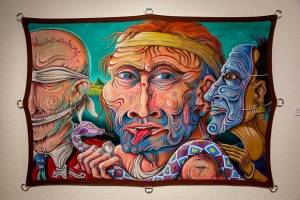 art. In my opinion, indifference is damning, but if looking at a piece evokes any feeling, positive or negative, then it is something worth investigating. Glen C. Davies’ gorgeous grotesquerie spoke to me about toxic speech, I was grumpy towards the found object collections, fascinated by the porcelain portholes, and I can’t even describe the painting Documentation (or Cat Video, the title is different on the website) — you have to go see that for yourself. I had ideas and questions bouncing around since Thursday, so when I returned on Saturday with a friend to bounce those off, I also got to see what her feelings and ideas were in return. All of these feelings prompted us to spend real time staring and parsing, and when I did, I found my discomfort turning into discovery.
art. In my opinion, indifference is damning, but if looking at a piece evokes any feeling, positive or negative, then it is something worth investigating. Glen C. Davies’ gorgeous grotesquerie spoke to me about toxic speech, I was grumpy towards the found object collections, fascinated by the porcelain portholes, and I can’t even describe the painting Documentation (or Cat Video, the title is different on the website) — you have to go see that for yourself. I had ideas and questions bouncing around since Thursday, so when I returned on Saturday with a friend to bounce those off, I also got to see what her feelings and ideas were in return. All of these feelings prompted us to spend real time staring and parsing, and when I did, I found my discomfort turning into discovery.
By far, I spent the most time on both trips taking in Nkata, the installation that I got to see in-process earlier in the week. Through the sliding glass doors, in the Contemporary Gallery, Nnenna Okore’s room-sized sculpture of frayed, dyed, and re-woven burlap is a full sensory experience as she projects light through it and plays recordings of ambient sounds recalled from her childhood in southeast Nigeria. My Saturday friend even observed that the room had a new-dye smell that seemed to fit in with the experience, and she wished it was intentional. While all the promotional material talks about words and conversations and baskets (derived from the dual meaning of the Igbo word that is the installation’s title), we both had very visceral reactions to the environment — the structures, sounds and even light provoking thoughts of what it would be like to be inside a body.
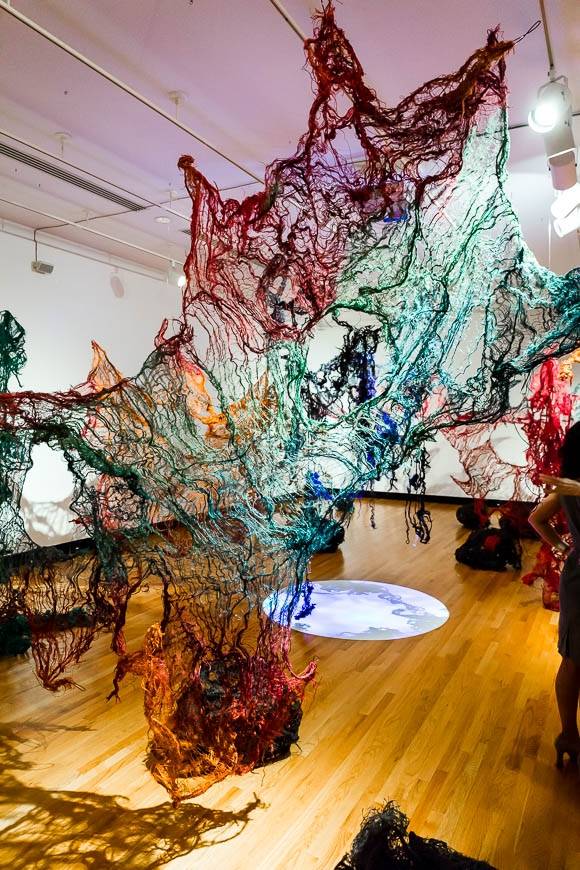
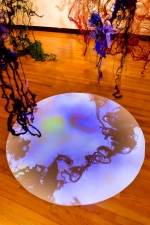 Being glasses-wearers, to both of us the round projection of light brought to mind the experience of catching a circular reflection of your own eyeball in a piece of dust on your lens, or of having a retinal photograph taken. The pulsing, drumming sounds could be any number of biological processes, or even the outside world heard from inside the body, distorted. The burlap structures, even the black puffs on the floor, felt cellular. It was just an immediate reaction, but oddly, we both were comforted by it, and felt like we could spend hours just sitting inside or out of it, enjoying the environment. I definitely plan on doing so several times through the year.
Being glasses-wearers, to both of us the round projection of light brought to mind the experience of catching a circular reflection of your own eyeball in a piece of dust on your lens, or of having a retinal photograph taken. The pulsing, drumming sounds could be any number of biological processes, or even the outside world heard from inside the body, distorted. The burlap structures, even the black puffs on the floor, felt cellular. It was just an immediate reaction, but oddly, we both were comforted by it, and felt like we could spend hours just sitting inside or out of it, enjoying the environment. I definitely plan on doing so several times through the year.
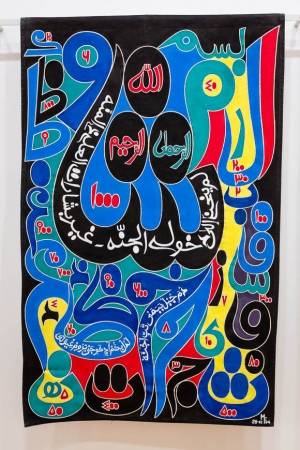 The last and largest exhibition, Tamarind Institute and the Rebirth of Lithography, is the first one I saw as it takes up the large room to the right of the entrance (the Rosann Gelvin Noel gallery), and leads to all the other rooms. While the term “Lithography” may bring to mind “posters”, a thought which is reinforced by the room full of … posters… the process itself is a skilled one. Regardless of the artist’s design, the success of the print relies on the skill of the printmaker. Think about any poster you’ve purchased where the colors just don’t line up. How would a mistake like that affect what we think about de Kooning or Toulouse-Lautrec? What if the first Escher seen had a huge ink smear on it? Suddenly, Kevin Smith’s echoing chide “oh, you trace” to the colorists in the comic book industry took on more significance. To that end, the placards for these prints all list the printmaker’s name alongside the artist’s, and I found out that my eyes were most often drawn to work printed by Stephen Britko (not pictured right). Maybe we just like the same artists, or maybe he is especially good at his job. Either way, I’m a fan.
The last and largest exhibition, Tamarind Institute and the Rebirth of Lithography, is the first one I saw as it takes up the large room to the right of the entrance (the Rosann Gelvin Noel gallery), and leads to all the other rooms. While the term “Lithography” may bring to mind “posters”, a thought which is reinforced by the room full of … posters… the process itself is a skilled one. Regardless of the artist’s design, the success of the print relies on the skill of the printmaker. Think about any poster you’ve purchased where the colors just don’t line up. How would a mistake like that affect what we think about de Kooning or Toulouse-Lautrec? What if the first Escher seen had a huge ink smear on it? Suddenly, Kevin Smith’s echoing chide “oh, you trace” to the colorists in the comic book industry took on more significance. To that end, the placards for these prints all list the printmaker’s name alongside the artist’s, and I found out that my eyes were most often drawn to work printed by Stephen Britko (not pictured right). Maybe we just like the same artists, or maybe he is especially good at his job. Either way, I’m a fan.
If you’re looking to “hit the highlights” of the new exhibitions, you can certainly do so, and I hope the pictures and advice here will help you to do that during a lunch break or quickly after work. If you’re paying attention at all, however, I think these pieces will tug at the back of your brain until you return and give them time to really speak with you, easily consuming half of your Saturday without you even noticing.
Each of the new exhibitions is on display through December, with Attachment ending on 12/12, and the rest staying up through 12/23. KAM is open Monday-Saturday, 9 a.m.-5 p.m. and is located at the corner of Peabody and Sixth.
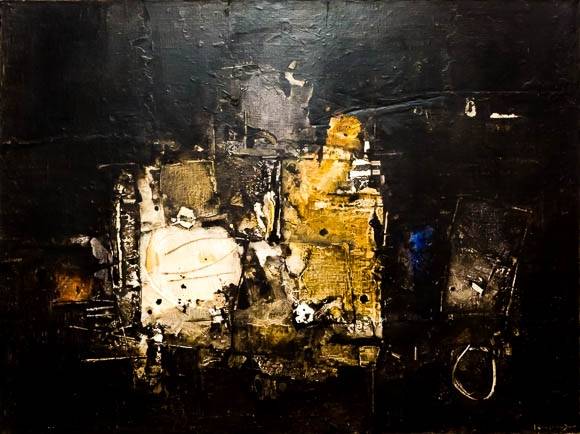
What? I just like this one.
All photos taken by Scott Wells with permission of the Krannert Art Museum, excepting the image of Guen Montgomery, taken by Julia Kelly.








